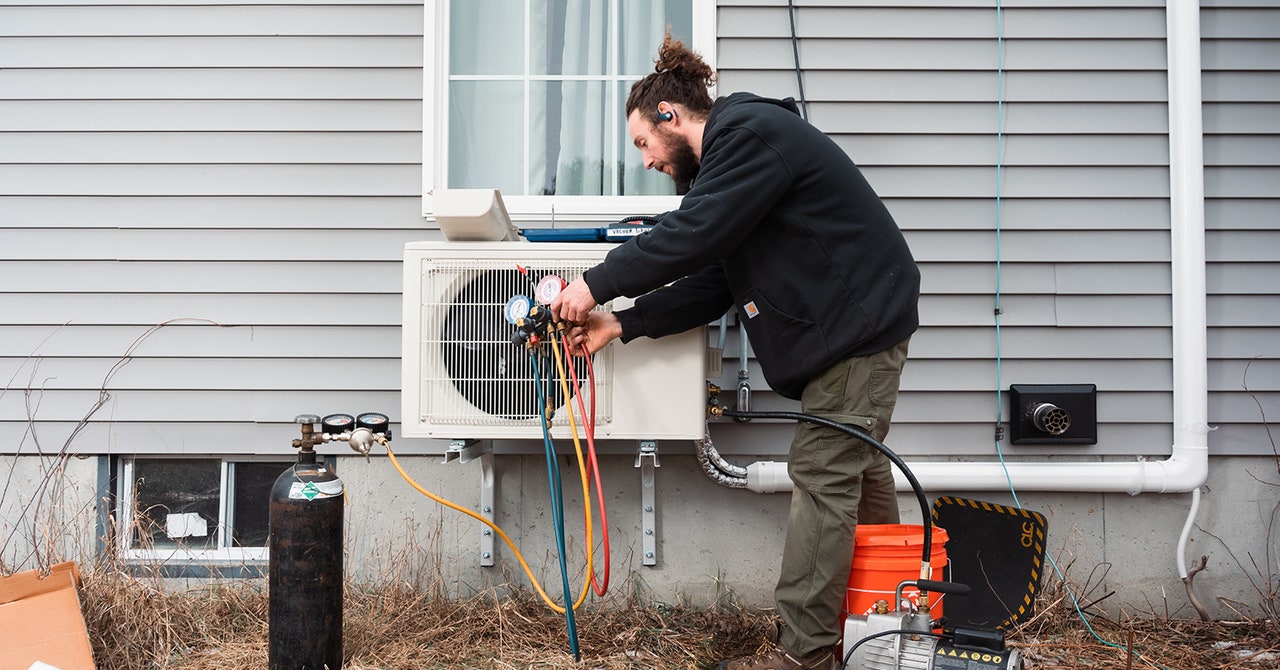If billionaires actually cared about saving the planet, they’d pool their vast wealth and buy everyone a heat pump. Instead of burning planet-warming fossil fuels, these appliances extract warmth from even freezing outdoor air and transfer it into a building, thanks to neat tricks of physics. In the summer, they reverse to act like an air-conditioning unit. One recent study found that if everyone in the United States got a heat pump, it’d slash emissions in the building sector by 36 to 64 percent, and cut overall national emissions by 5 to 9 percent. (Because they’re fully electric, heat pumps run on a grid increasingly loaded with renewable energy.)
Not that billionaires would ever have the altruism or desire to buy us all heat pumps—megayachts aren’t going to buy themselves, after all. But if they did, there’d be one critical hurdle they’d run into—the one thing that’s holding heat pumps back from their full potential more generally: There aren’t enough trained workers yet to install them.
“No one talks about supply chain constraints anymore. What is now the bottleneck is actually the installer,” says Philipp Krinner, CEO and cofounder of Arch, a platform that helps HVAC (heating, ventilation, and air-conditioning) companies manage customers. “In the winter and in the summer—in the peak seasons—when most people actually want to install a system, it’s actually still a contractor-constrained market.”
The result is classic “greenflation,” a temporary rise in the costs associated with decarbonization due to market constraints, says climate economist Gernot Wagner of the Columbia Business School in New York. “Yes, there is a shortage of qualified contractors,” he says. But it’s a good problem to have, he argues, and “one where there’s an obvious solution” on the road to decarbonizing our civilization. It’ll be costly to train more workers in the green economy, but that’ll end up paying huge dividends.
“Electricians get talked about a lot, and used as sort of an avatar for all of the jobs that are going to be needed to install heat pumps and decarbonize the economy,” says Alexandria Herr, senior research associate at Rewiring America, a nonprofit that promotes electrification. “But it’s not just electricians—it’s actually a whole range of different jobs across the construction trades.” Qualified workers are needed to determine what kind of heat pump a home or business requires, to install the things, and then to service them. A heat pump is fundamentally different from a gas-fired furnace, and it requires fundamentally different training.
That would include workers specializing in “weatherization”—better insulating homes so heat pumps get even more efficient. And we’ll need specialists to retrofit the grid so it can smoothly transition to handling the ebb and flow of renewable energy, which is what makes heat pumps so climate-friendly. And we’ll need workers in manufacturing to produce the units themselves.
And we need these people ASAP. Heat pump sales are already outpacing the sale of gas furnaces in the US. The Inflation Reduction Act of 2022 provides thousands of dollars in tax rebates and credits for households to both switch to a heat pump and pay for the electrical upgrades that may be required to run the appliances. Last year, the Biden administration announced $169 million to supercharge the domestic manufacturing of whole heat pumps and their individual components. And in February, nine states signed a memorandum of understanding to accelerate the adoption of heat pumps.
So the demand is there, as is growing support from the federal and state governments. What’s lagging is the workforce—at least temporarily. And the US is nowhere near alone: Wherever heat pump adoption is growing, more workers need to train up to meet demand. “If you look at a place like, say, Finland, where pretty much all your heating systems are heat pumps, this is not really an issue anymore,” says Jan Rosenow, who studies electrification at the Regulatory Assistance Project, a policy NGO for the energy community. “If you wanted to buy an electric car 10 years ago, it was quite difficult, wasn’t it? Now, you can go to any showroom and you can find them. I think the same is going to be the case with heat pumps. It’s already the case with heat pumps in more mature markets.”
In the US, though, we don’t have some sort of giant, national program to quickly get more people trained in HVAC. “It would just make sense that there would be this path to learn more about heat pumps, and then there would be a whole armed force to go out and install these things,” says Ed Janowiak, manager of HVAC and refrigeration design education at the nonprofit Air Conditioning Contractors of America. “There is such an opportunity right now for people to get in on the ground level. It should not take them very long to make a decent wage at it. And I still sit here at times with my palms in the air as to why it isn’t just automatically happening.”
There isn’t one official pathway in the US for HVAC workers, but several. Trade schools and community colleges provide HVAC training. Trade unions offer apprenticeships, and many HVAC companies run their own training programs to get people into the trade. “The most successful companies right now that are finding these people to install, they’re not necessarily hiring people that are already in the field,” says Janowiak. “But if you look at the number of technicians that go through those programs nationally, versus the demand, it’s just not there. So we need a lot more people.”
For veteran HVAC workers already trained in fossil-fuel systems, like installing gas furnaces, heat pump manufacturers provide their own training to install their products, which is of course in their interest. HVAC companies also do their own heat pump training for established workers, which usually takes two days. If a home has ducting, a heat pump will work similarly to a traditional AC unit, so the installation is nearly identical.
But all these workers don’t just have to be trained, but trained well, lest they inadvertently turn customers off of the energy-efficient appliances just as the heat pump revolution is getting going. If the size of the heat pump doesn’t suit the size of the home, or the ducting within, it won’t be as efficient. If you don’t have ducting, a contractor might recommend a simpler ductless heat pump, which is set into an outside-facing wall. “My biggest hope is that those people who do end up installing these, do get trained wisely,” says Janowiak, “and they do install pieces of equipment that work the way we want them to.”
An added challenge is that the US needs a robust network of training programs all across the country: You can’t have someone remotely install a heat pump, which means we’ll need not just an army of trained workers, but a properly distributed one.
Over in the UK, the energy supplier Octopus Energy has even built two full-scale model houses for workers to train in, one representing modern housing stock and the other older brick stock from the 1960s or 1970s. The company uses the homes to train workers new to the heating industry—it directly employs these folks during the education process, so they get paid—but also to reskill veterans who’ve been installing fossil-fuel systems. “Actually, we don’t really have a skill shortage at all—we just have a set of people that are installing the wrong product,” says John Szymik, CEO of Octopus Energy Services. “We built those [model homes] in order to show people how you’d optimize a rollout for the mass market.”
Working in an older UK home, for instance, technicians need to account for much worse insulation than in a modern home. The size of the home matters, as does the number of occupants and kinds of windows. All that data goes into a calculation that Octopus uses to determine the size of the heat pump. “Those homes are really, really helpful for our surveyors’ understanding of how to go around and measure up,” says Szymik. Then during a heat pump installation in the real world, a newly trained worker would join a crew of more experienced technicians. “What you get there is the opportunity to blend your people that have been working on this for a while, have more experience, with the people that are coming into it fresh with slightly less experience.”
A new breed of heat pumps is also making it possible for some people to skip hiring a trained installer entirely. The New York City Housing Authority, for instance, is deploying units that slip over a window sill and plug into the wall. One of the companies making that type, Gradient, says that a resident can install one in less than an hour, in contrast to a team of technicians installing a traditional heat pump in about a day. For an apartment dweller without ducting, this might be an ideal option that skips the extra step of having a contractor analyze the space and deploy a more complicated system.
The other option is to just hope the heat pump revolution unfolds smoothly on its own: Maybe the HVAC industry will meet that demand with American-made devices installed by newly trained workers. Finland, after all, eventually found its way. “There may well be the need for large-scale retraining programs,” says Wagner. “Maybe I’m too much of a business school economist—please excuse me of that—but frankly, one answer is to simply get out of the way and let the market do its thing.”



I just got one installed last week. Just under 15k as the list price, but all the rebates available got it to $5200 out of pocket. I was already using an electric furnace though, so this should just be straight savings going forward.
Good luck with it! Since we haven’t been using anything other than a single window a/c unit on the very hottest summer nights, I expect that it will cost us more. But we’ll still be greener than we could be otherwise.